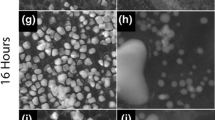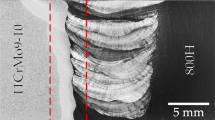Abstract
The next generation of Ni-based alloys for aeroengines are richer in γ′ than existing alloys and are more difficult to weld by conventional means. Inertia welding is currently being developed as a joining technique for these alloys. Steep microstructural gradients have been observed in nickel-based superalloy RR1000 tube structures welded by inertia friction welding,[1] and in this article, the concomitant residual stresses are mapped at depth using neutron diffraction. One tube in the aswelded and two in the postweld heat-treated (PWHT) condition have been investigated. In the case of the as-welded specimen, it was necessary to establish the variation of the stress-free lattice parameter, a 0, across the weld line to infer elastic strain from lattice spacing changes. A biaxial sin2 ψ measurement on thin slices was used to determine a 0 as a function of the axial position from the weld line. This was in excellent agreement with the variation inferred by imposing a stress balance on the axial measurements. The change of a 0 across the weld line can be rationalized in terms of the observed variation in the element partitioning effect between the matrix (γ) and the precipitates (γ′). It was found that the residual stresses in the weld and heat-affected zone generated by the welding process are large, especially close to the inner diameter of the welded ring. The experimental results have shown that, in order to relax the residual stresses sufficiently, the heat-treatment temperature must be increased by 50 °C over the conventional heat-treatment temperature. This is due to the high γ′ content of RR1000.
Similar content being viewed by others
References
M. Preuss, J.W.L. Pang, P.J. Withers, and G. Baxter: Metall. Mater. Trans. A, 2002, vol. 33A, pp. 3215–25.
H.G. Priesmeyer and J. Schroeder: Residual Stresses—III: Science and Technology, H. Fujiwara, T. Abe, and K. Tanaka, eds., Elsevier Applied Science, London, 1992, pp. 253–58.
M.E. Abdel Moniem, S.M. Serag, A.A. Nasses, and A.A. Moustafa: Wear, 1981, vol. 70, pp. 227–41.
H.U. Baron: 3rd Int. Conf. on welding in Aerospace Industry, German Welding Society, Essen, 1993, pp. 114–17.
J.W.L. Pang, M. Preuss, P.J. Withers, and G.J. Baxter: 6th Conf. on residual stresses (ICRS-6), IOM Communication, London, 2000, pp. 1415–21.
J. Schroeder: Ph.D. Thesis, Technische Universitaet Hamburg-Harburg, Hamburg, 1993, p. 119.
M.W. Johnson, L. Edwards, and P.J. Withers: Physica B, 1997, vol. 234, pp. 1141–43.
R.A. Young: Rietveld Method, Oxford University Press, Oxford United Kingdom, 1993.
J.W.L. Pang, G.J. Baxter, P.J. Withers, G. Rauchs, and M. Preuss: Oak Ridge National Lab., Oak Ridge, TN, unpublished research, 2001.
H.J. Stone, T.M. Holden, and R.C. Reed: Scripta Mater., 1999, vol. 40, pp. 353–58.
I.C. Noyan and J.B. Cohen: Residual Stress, Measurement by Diffraction and Interpretation, Springer-Verlag, Berlin, 1987, pp. 122–25.
L. Edwards, J. Santisteban, M.E. Fitzpatrick, G. Bruno, A. Steuver, P.J. Withers, M.R. Daymond, and M.W. Johnson: 6th Conf. on Residual Stresses (ICRS-6), IOM Communication, London, 2000, pp. 1239–46.
D. Blavette, A. Bostel, and J.M. Sarrau: Metall. Trans. A, 1985, vol. 16A, pp. 1703–11.
Author information
Authors and Affiliations
Rights and permissions
About this article
Cite this article
Preuss, M., Withers, P.J., Pang, J.W.L. et al. Inertia welding nickel-based superalloy: Part II. Residual stress characterization. Metall Mater Trans A 33, 3227–3234 (2002). https://doi.org/10.1007/s11661-002-0308-x
Received:
Issue Date:
DOI: https://doi.org/10.1007/s11661-002-0308-x




